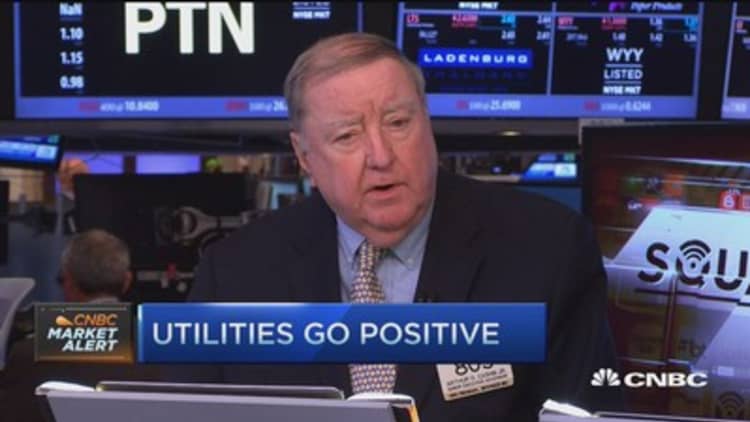
The has turned in pretty dull performance so far in 2015. It went negative on the year Thursday—but is basically flat—and in the past one-year period, is up about 3 percent.
The S&P's mediocre performance raises a question. If the market stays on its current up-and-down course and the U.S. stock market finishes 2015 hemming and hawing, what does S&P 500 historical data suggest: time to buy or more proof it's time to head for the exits?
The long-term data does provide an answer. A feeble return has been a bull indicator.
Going back to 1918, there are 11 instances of calendar years in which the S&P 500 was up or down by 3 percent or less, according to S&P Capital IQ. In the subsequent calendar year, the market rose an average 13.3 percent and gained in price 82 percent of the time (nine of 11 instances), according to data from Sam Stovall, chief investment strategist at S&P Equity Research Services.
Read MoreClassic market overshoot is developing: El-Erian
Narrowing the screen to +/-2 percent, the average subsequent return for the S&P 500 rises to roughly 15.3 percent and the frequency of advance goes up to 89 percent (eight of nine instances).
The 'dull' but enlightening history of S&P 500's weak years
| Year | Price | 1-year change in index | *S&P 500 return following a flat year |
|---|---|---|---|
| 1956 | 46.67 | 2.6 | -14.31 |
| 1947 | 15.30 | 0.0 | -0.65 |
| 1948 | 15.20 | -0.7 | 10.26 |
| 1970 | 92.15 | 0.1 | 10.8 |
| 1978 | 96.11 | 1.1 | 12.31 |
| 1987 | 247.08 | 2.0 | 12.4 |
| 2011 | 1257.60 | 0.0 | 13.4 |
| 1923 | 8.82 | -1.5 | 18.71 |
| 1960 | 58.11 | -3.0 | 23.13 |
| 1984 | 167.24 | 1.4 | 26.33 |
| 1994 | 459.27 | -1.5 | 34.11 |
| Average: 13.32 |
(*Note: Sorted by S&P 500 annual return following a "flat" year.)
Howard Silverblatt, senior index analyst at S&P Dow Jones Indices, said the big caveat to looking at the long-term data in a vacuum is the growing and obvious concern over "COF"—China, oil and the Fed. But he expressed slightly brighter-than-cautious optimism.
"It's not a fun market right now, but the past 23 years has been, and if this is the 'payback' for that—which at this point is a break-even year—sign me up again," said Silverblatt.
There is at least one interesting point of comparison between the current year and past years of weak S&P 500 performance, according to Nicholas Colas, chief market strategist at Convergex.
Both 1984 and 1994 were the start of Federal Reserve rate cycles—1984 was easing and 1994 tightening. (1956 was also the beginning of a Fed rate cycle, though to a less significant degree.)
Read MoreFed rate hike speculation is getting nuts
Colas said in 1994 when he was analyzing autos, the stocks were moving from major leaders to market laggards as the first rate rise loomed. Even though it was somewhat expected, it caught the market by surprise, but the year still ended flat.
"Now it's analogous. The Fed has told us what they would like to do, we just don't know when and the cadence is in question," Colas said. "That creates uncertainty and a flat market, and once uncertainty is past, you get better returns the following year."
He added that the Fed move is not likely to be as severe as it was in 1994.
That year the hike in the fed funds rate was big, starting at 3.05 percent and ending the year at 5.45 percent. "The speed of that move caught the markets by surprise, and this time the Fed has promised to not be as metronomic as during the Greenspan era," Colas said.
Still, Fed uncertainty is a big caveat to set against the data. The market doesn't know the answer yet, and there is no guarantee that once the Fed moves, investors will move on, or more uncertainty follow.
It's not a fun market right now, but the past 23 years has been, and if this is the 'pay back' for that—which at this point is a break-even year—sign me up again.Howard Silverblattsenior index analyst at S&P Dow Jones Indices
Colas said whenever investors look to annual analysis of returns they have to keep in mind that the calendar year is "an artifice of mankind." Additionally, a lot can happen between now and the end of the year which changes the current flat year for the S&P 500 to a significant level.
However, Colas said with the S&P 500 at just above 3 percent for the past year, "right against the 3 percent level," if you make the assumption the data work in a rolling 12-month cycle, it's in the least worth considering buying the S&P 500 for a one-year holding period.
There may be too many variables to put a fat finger on the S&P 500 buy button as a result of one statistical anomaly, but in the least, if the fourth quarter rolls around and the S&P 500 is still in flat territory, the long-term index data are worth weighing.
Stovall summed up the long-term historical S&P 500 data in terms of tried and true market proverbs.
"I guess you could say that the adage 'never short a dull market' applies to dull years as well," he said.


